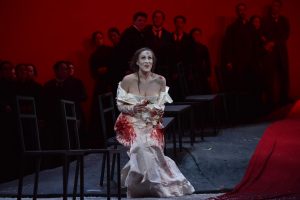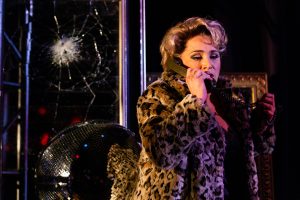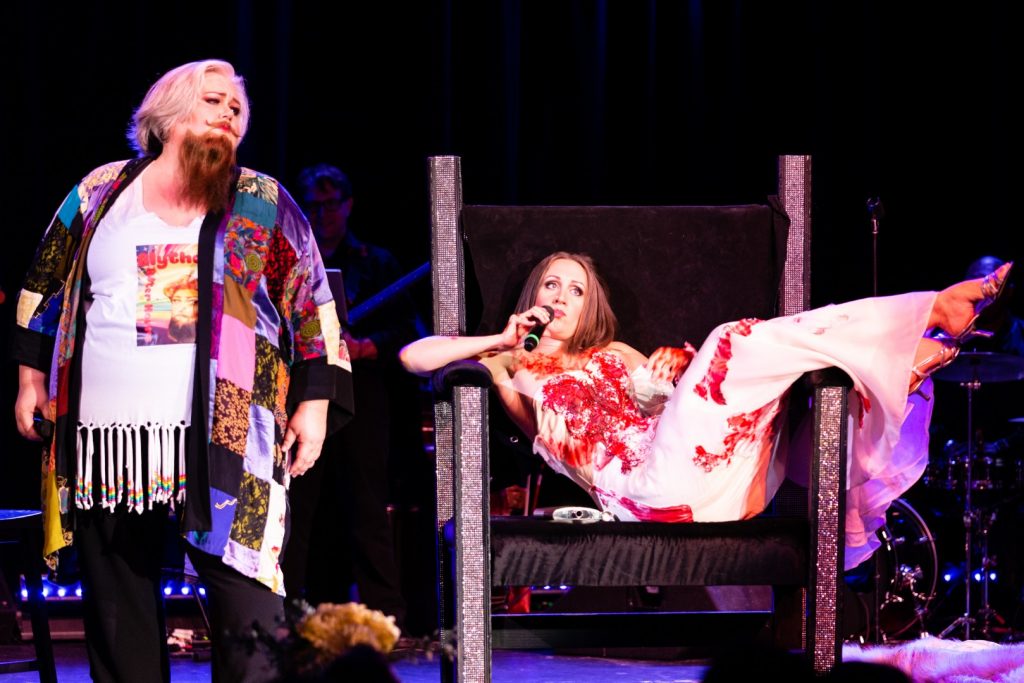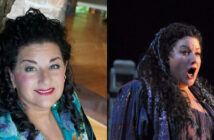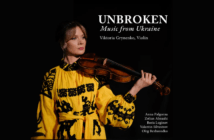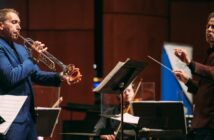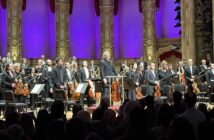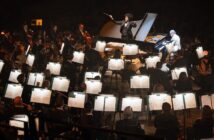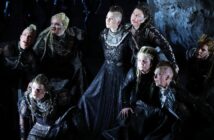REVIEW: of Opera Philadelphia’s “Festival O18” (September 20-30, 2018) – a new production of Lucia di Lammermoor, composed by Gaetano Donizetti with libretto by Salvadore Cammarano; the world premiere of Sky on Swings, composed by Lembit Beecher with libretto by Hannah Moscovitch; the premiere of Ne quittez pas (a “reimagined” La voix humaine of Francis Poulenc, with a new prologue featuring numerous of the composer’s art songs); the premiere of Glass Handel, an immersive concert experience featuring countertenor Anthony Roth Costanzo performing music by George Frideric Handel and Philip Glass; and Queens of the Night: Blythely After Hours, an opera/rock cabaret starring mezzo-soprano Stephanie Blythe, with special guests.
Opera Philadelphia’s Festival O18 blazed a wide swath through its home city from September 20 through 30, with an incendiary dazzle of musical events ranging from the time-honored to the cutting-edge.
2018 saw the second September in a row that the company deployed its resources in an innovative and tightly concentrated calendar of programming, marked by a multi-venue, “city-as-stage” strategy that again distinguished Opera Philadelphia’s as among the gutsiest, most adventurous and at times even most merrily subversive of comparable opera-making organizations around.
Lucia of the Snows
(Lucia di Lammermoor: performed September 21, 23, 26, 28 and 30; viewed September 23.)
Opera Philadelphia debuted a wintry, haunted new production of Donizetti’s Lucia di Lammermoor, directed by renowned homme de théâtre Laurent Pelly in his own first company outing.
Presented at Philadelphia’s venerable and sumptuous Academy of Music, the action unfolded amidst a misty and snowbound landscape, as evocative of the world of Zhivago and Lara as the scions of the feuding Scottish clans of Ashton and Ravenswood. It was a bold, recherché choice, and yielded potent subliminal dividends, the environment of undulant snowbanks proving not only daunting to navigate, but metaphorically uberous in its mirroring of the frozen enmities and situational implacability of the opera’s inner world.

An intruder has been spotted on the
grounds of Lammermoor Castle in Lucia di
Lammermoor at Opera Philadelphia; photo by Steven Pisano
Ghosts, seen and unseen, have rarely been so active as in this Lucia. Following the orchestra’s exquisitely rumbling and ominous rendering of Donizetti’s prelude (under Opera Philadelphia’s invaluable music director, maestro Corrado Rovaris), the first vision to meet the audience was a tantalizing, interpolated appearance of a spectral woman on a frigid hill. Thereafter, the opera’s deep thematic pedal tones of undying grievances and obsessive memories mingled thickly in a general, gathering atmosphere of supernatural dread.
The opera is, of course, a famously successful reworking of Sir Walter Scott ‘s novel The Bride of Lammermoor – a tale of doomed love, dynastic rivalry, sexual manipulation, and madness set in the hill country of southern Scotland (originally placed in the 18th Century; here transposed to the mid-19th). Oft-remarked are the opera’s parallels with Romeo and Juliet; but, in contrast to the earnest naïfs of the latter, the lovers of Lammermoor are a decidedly darker, more complex pair, a fact richly explored in Pelly’s treatment. Edgardo is a man of such mixed genitive, amatory and political motives that he himself seems hard-pressed to disembroil them. Then there’s Lucia, a highly-strung, suggestible, superstitious, and constitutionally compromised creature all too easily made a pawn in the power games of the men around her.
The production boasted a phenomenal concentration of vocal artistry, and Pelly elicited performances of full-bore hyper-naturalism and psychological depth from all his principals, headlined by tenor Michael Spyres in a magnificent company debut as Edgardo, and superlative bel-canto soprano Brenda Rae as the opera’s doomed title heroine.
Spyres and Rae are a Lammermoor dyad for the ages – singers each possessed not only of enormous technical mastery, but fearsome acting chops to boot, and generating between them a compelling erotic chemistry – no mean feat, given that the opera actually affords them only two extended shared scenes: one in which they spend the lion’s share bidding each other farewell, and another in which Lucia is rendered largely mute against the aggrieved Edgardo’s mistaken jilted-lover vituperations.
Spyres, with a voice combining ineffable purity with rare dramatic heft, rang true of passion and intelligence throughout a consummately modulated performance, mustering in scintillating succession his Edgardo’s impulses of rash lover, political calculator, preening idealist, and self-destructive Byronic romantic. Spyres’ handling of the opera’s extended finale – with its suicidal valedictory amidst the graves of his ancestors (“Frà poco a me ricovero”) – was nothing short of shattering.
For her part, soprano Brenda Rae limned a jittery, damaged Lucia in a performance of thrilling vocal brinksmanship and psychological verismo, making every shivering flight of fioritura in this famously ornate Donizetti role seem the spontaneous emanation of authentic inner turmoil. Rae’s searing performance of the Act III “mad scene” (here accompanied replete with Donizetti’s original glass harmonica part) was fearlessly physical, intricately detailed, shockingly eroticized, and vocally awesome, the lacerating whip of her coloratura chining the psychic rachis of Donizetti’s rangy and expressive lines into an iridescent, aural shower-spray of anguish-tinctured particulate.
In other performances, baritone Troy Cook brought vocal opulence and suave wickedness to the role of Lucia’s brother (and Edgardo’s nemesis), Enrico Ashton; bass Christian Van Horn (this year’s Richard Tucker-Award winner) brought luscious vocal warmth to the role of Lucia’s solicitous counselor, Raimondo; mezzo-soprano Hannah Ludwig evinced hoydenish vigor and hardy tones in the role of Lucia’s maidservant, Alisa, admirable in her game efforts to wrangle her mistress out of the snow and back to sanity; tenor Andrew Owens offered arch hauteur and supple vocalism as Lucia’s supercilious suitor, Arturo; and robust-voiced tenor Adrian Kramer played Enrico’s sinister retainer Normanno with effectively understated insinuation.
Director Pelly’s staging novelties in this Lucia were manifold, including the stylized yet organic behavioral code he crafted for his chorus; the brilliant notion of turning a large portion of Edgardo’s Act I duet with Lucia into a figment of the latter’s febrile imagination; and an utterly wicked and witty, “bait-and-switch” staging of Lucia’s bloody wedding banquet entrance.
And it would be remiss to overlook the handling of the celebrated sextet, “Chi mi frena,” that weird and wonderful bit of stop-motion dramaturgy. Avoiding mere ornamental stateliness as well as any all-too-common ensemble bombast, Pelly and conductor Rovaris rather offered rare and privileged access to the piece’s buried lyric map of tormented emotions and motivations – a phrenic MRI of aching, interlaced, collective conscience.
With its sterling cast, frosty set design by Chantal Thomas, grayscale costume designs by director Pelly, and moody lighting by Duane Schuler, this was a Lucia that lingers in the mind – stark, bleak, beautiful, like a spill of blood on snow.
Focusing In, Fading Out…
(Sky on Swings performed September 20, 22, 25, 27 and 29; viewed September 22.)
Sky on Swings, a new opera by composer Lembit Beecher and librettist Hannah Moscovitch, is an engrossing, humane and unflinching study of the clinical, emotional and familial challenges of Alzheimer’s disease.

Martha (mezzo-soprano Marietta Simpson) and Danny (Frederica von Stade) bond in an Alzheimer’s care facility; photo by Dominic M. Mercier
Featuring powerful central performances by two excellent singing actresses – the distinguished mezzo-sopranos Frederica von Stade and Marietta Simpson – the opera tracks the intersecting lives of two women afflicted by the insidious neurological scourge, yet manages to tell their stories with warmth, compassion, and even a healthy measure of redemptive humor.
Von Stade played Danny, a professional academic researcher apparently just at the onset of symptomatic indications. In a delicate yet emotionally harrowing early scene, she agrees to take a home-administered memory test from her son, Ira. Having built a career on intellectual acuity, it is heartbreaking for both Danny and son to find her unable to repeat from memory a simple series of words.

Danny (mezzo-soprano Frederica von Stade) and son Ira (tenor Daniel Taylor) realize she has Alzheimer’s; photo by Steven Pisano
Simpson plays Martha, a woman farther along the disease’s baneful and painfully gradual course, now resident in a nursing facility. Regularly reverting to a belief that she is home in her own apartment, Martha’s fraught confrontations with her attentive but impatient daughter, Winnie, are handled with raw honesty.
When Danny decides to preempt any belated crisis and commit herself early to residency in the same nursing home as Winnie, the two women develop a complex relationship of shifting dependencies, solicitudes, and camaraderie. A tastefully handled, if arguably superfluous, subplot of dimly recalled girlhood homoeroticism occupies a portion of the opera’s central development, before a musically haunting and inevitably enigmatic finale that mingles resignation, affirmation, and a false-dawn illusion of redemption. At the intersection of loneliness and bravery, the sufferers must somehow each make a psychic separate peace.
Along with the journeys of the two central characters, the opera traces the parallel emotional lives of the women’s adult children. Ira is played with affecting vulnerability by the warm-voiced, teddy-bearish tenor Daniel Taylor; and Martha’s deceptively sangfroid daughter Winnie is etched with keen, bevel-edged voice and equally precision-cut emotion by soprano Sharleen Joynt.

Danny (Frederica von Stade) and Martha (mezzo-soprano Marietta Simpson), with the Elder Chorus; photo by Dominic M. Mercier
Moscovitch’s libretto is incisive, dramatically savvy, and admirably accessible while still managing to maintain a certain dignified sense of mystery (an opening “Elder Chorus” deploys medical-journal lingo in curtailed, fragmentary fashion that brilliantly captures both laicized dread at confronting the disease, and the subjective terror and confusion that must attend the patient’s experience of it).
And Beecher’s score is varied, searching, restless, unprepossessingly sophisticated, and marked by astringently beautiful and dramatically supportive vocal lines.
Joanna Settle directed the opera with fluidity, intelligence and sensitivity.
An attractive minimalist set by Andrew Lieberman, with lighting by Pat Collins, was surmounted by a tangled strand of fluorescent lighting tube which, on occasion, gave the ingenious illusion that its own shadow was spontaneously writhing into the spectral scripted longhand of certain words – an impactful metaphor for the tangling and bunching of neurons that are speculated to accompany the disease.
Conductor Geoffrey McDonald did Beecher’s score proud, as did the four-strong choral ensemble of soprano Veronica Chapman-Smith, alto Maren Montalbano, tenor George Somerville, and bass Frank Mitchell.
Performed in the sleek, intimate, and acoustically admirable Perelman Theater of Philadelphia’s Kimmel Center for the Performing Arts, Opera Philadelphia’s world premiere of this significant new work was programmed in conjunction with informative “community conversations” that featured speakers from Alzheimer’s research initiatives and patient support organizations.

Martha (mezzo-soprano Marietta Simpson) and Danny (Frederica von Stade) enter a surrealist landscape together; photo by Dominic M. Mercier
The Walls Have Ears…
(Ne quittez pas: a Reimagined La voix humaine performed September 22, 23, 27, 29 and 30; viewed at the September 22 opening.)
The seedy glamor of Philadelphia’s popular, multi-discipline music and arts venue, the Theatre of Living Arts (or TLA), was a large part of the inspiration for director James Darrah’s “reimagined” and expanded presentation of Francis Poulenc’s renowned monodrama, “La voix humaine,” here in an evening newly titled “Ne quittez pas.”
Choosing to construe TLA, a large South Street lounge/bar/dance club, as a Parisian discotheque circa 1979 (“…or maybe it was 1980, they can’t remember,” according to Darrah’s program), the company created an entirely new one-act curtain-raiser to precede the soprano solo piece.
The new plot: the discotheque is closed; a moody, mute club pianist is running through selections from his more highbrow repertoire when a trio of high-spirited night revelers come knocking. Against prudence, the pianist opens the club to them, and a bizarre, sexually-charged, Cocteau-inspired youth invasion ensues.
It turns out that two of the invading strangers are grownup, alternate-universe incarnations of Paul and Elisabeth, the amoral siblings of Cocteau’s infamous 1929 novel Les enfants terribles (here played by Marc Bendavid and Mary Tuomanen). The third newcomer is a young American, Le jeune homme (baritone Edward Nelson), whom the brother and sister have somehow beguiled into accompanying them on their perverse nocturnal predations.
The enfants proceed to seduce the pianist into playing, and the American into singing, a series of pithy, offbeat, enigmatic, and erotic songlets – a concatenation that happens to comprise Poulenc’s mini-cycle of Apollinaire-inspired art songs, “Banalités,” plus his eight ironically titled “Chansons gaillardes” (“bawdy songs”). Structured around these, Paul and Elisabeth treat the singer and the pianist to various sexual humiliations, temptations, and favors, as they themselves cross-dress, boss, bully and scandalize.
It was all quite titillating fun, engaging in its intensity, mischief, and randomness, affording a luxe foray into last-millennium aesthetic psychedelia as well as providing a theatrically expedient way of showcasing Nelson’s warm and lovely vocal performances and pianist/music director Christopher Allen’s elegant virtuosity.
If any actual “theme” were to be decocted from these doings, it might inhere in the manifest paradox of the scenario’s two actual musical “performers” – singer and pianist – being the effectively passive players in the drama, while their putative “audience” – Paul and Elisabeth – were the real movers and shapers of events. Inversions abounded.
After an intermission, Poulenc’s “La voix humaine” – that taut, forty-minute mini-opera for soprano and telephone, adapted from Cocteau’s monologue play of the same name – was performed by well-regarded chanteuse/pedagogue Patricia Racette, accompanied by music director Allen at the piano.
It should have been the evening’s highlight – and, for many, may well have been so.
But for anyone who had found himself unexpectedly sucked in by the verve and novelty of the evening’s earlier dissipations, it might have been forgiven to regard the dilations of a desperate, discarded, emotionally threadbare mistress with postfeminist indifference.
Yes, Racette unquestionably pulled out the stops in attacking this reliably showy showpiece, and seemed vocally unimpeachable. Yet, remarkably, this self-described “Diva on Detour” of oft-cited acting ability appears to have committed cardinal technical infractions against the playing of telephone scenes (cf. Uta Hagen), all too frequently casting her glances and focus downward, thus thwarting crucial audience access to facial expressions and the transparency of moist eyes and fatuous, martyrized soul.
Musical Chairs
(Glass Handel performed September 22, 23 and 30; viewed September 23.)
To read countertenor Anthony Roth Costanzo’s account of putting together Glass Handel is to marvel at the occasional munificence of the universe. Acting out of evidently pristine karma, not to mention immense talent, grit, and determination, Costanzo has generated a singular alignment of stars in a firmament that includes renowned visual artist George Condo, fashion legend Calvin Klein and designer Raf Simons, filmmaker James Ivory, choreographer Justin Peck, and dance stars Patricia Delgado and David Hallberg, along with the innovations of contemporary art installation experts VISIONAIRE.

Anthony Roth Costanzo in Glass Handel, costumed by Raf Simons for Calvin Klein; photo by Dominic M. Mercier
What might have become a confused and pretentious muddle of styles, motives, and egos instead yielded a well-blended theatrical experience – immersive, elegant, quirky, and beautiful – presented in the grand main reception salon of Philadelphia’s famed Barnes Foundation.
“Handel defined me,” says Costanzo, “and Glass changed me.” And with this unique, interdisciplinary framing of vocal works by the two composers, Costanzo has lavishly requited the boon. Based on the warm tidal drift of color and sound he originally presented in his album “ARC,” Costanzo brought luminous vocal life to an evening of selections more or less evenly divided between the baroque master and the contemporary minimalist wizard. Accompanied by members of the Opera Philadelphia orchestra, under the impeccable leadership of music director Corrado Rovaris, Costanzo was a veritable human cataract of gushing, gorgeous, potent and ethereal sound. The sense of hyperbaric aural submersion brilliantly demonstrated the two composers’ remarkable shared paradox of projecting seemingly infinite effect within tight economies of harmonies and rhythm.
Costanzo performed on a south-of-central dais, outfitted at first in what might be described as an enormous and amusing CK-couture version of a harlequin fat-suit, then progressively shed layers of costume as the performance progressed.
Augmenting this central vocal event were parallel dancerly, painterly, and visual-arts activities enacted at various “stations” around the expansive Barnes space.
At one such station, dancers Hallberg, Delgado, and Ricky Ubeda performed lithe and virtuosic passes (choreographed by Peck) atop a large, raised platform. At another, artist Condo, backlit shadow-play style behind a large translucent sheet, executed an enormous, neo-cubist group portrait of figures caught in variously rhapsodic and cryptic moods and moments. At a third station, audience members seated before large monitors watched customized videos created by a cadre of celebrity artists and performers, ranging from the weird and Bunuel-like, through the wry and humorous, to the patently adorable (priceless and poetic images of spaniels frisking about in slow-motion on idyllic beaches). The videos were the assorted handiwork of artists including Ivory and cinematographer Pix Talarico, director Mark Romanek; actress Tilda Swinton and her partner, visual artist Sandro Kopp; avant-gardist Tianzhuo Chen; filmmaker Daniel Askill; artist-photographer team Maurizio Cattelan and Pierpaolo Ferrari; director/writer Rupert Sanders; Russian artist collective AES+; and feminist media artist Mickalene Thomas.
Ingeniously, in order for each sector of the audience to enjoy each of the ancillary performance installations, a corps of regimented super-ushers discreetly approached each audience member’s chair in turn, gave the subject a discreet touch on the shoulder as signal, then engaged his or her chair on a handcart, smoothly rolling it to the next vantage point. The coordination of this complex of maneuvers was pulled off without a hitch. And while one might cynically liken the passive audience experience to that of an invalid being rolled from buffet to buffet, in the moment, it all seemed to suggest so much more: the enigma of autonomy versus subjugation to external forces; the illusion of plenary experience within a brevity of time; indeed, the mystery of time itself – all perplexities of consciousness actually reflected in the aesthetics of Handel and Glass.
Costanzo’s Glass Handel will next be mounted at New York City’s magnificent Cathedral of St. John the Divine in four performances over a two-day run, November 26 and 27 – a co-production by Opera Philadelphia and the Cathedral along with presenting organization National Sawdust, VISIONAIRE, and producer Cath Brittan. Accompaniment will be by New York-based orchestra The Knights under the baton of Eric Jacobsen.
Information is available at National Sawdust’s website: nationalsawdust.org/glass-handel.
Royal Audience
(Queens of the Night… was performed in three separate installments on September 24, 25 and 28; the first installment, Blythely After Hours, was viewed at the September 24 opening.)
To beard or not to beard…. That was the question….
And it was answered with a resounding affirmative by mezzo-soprano-cum-female-tenor Stephanie Blythe, who this season once again donned whiskers and let down her hair to channel her irrepressible alter-echo and homme de musique extraordinaire, fictitious tenor Blythely Oratonio, in this latest edition of Blythe’s evolving series of camp/opera/pop/cabaret evenings.
This time, Blythe ushered us into the presence of the loquacious great man holding court in an onstage dressing room and waxing expansively on life, love, art, and the sound of his own voice.
And singing. Boy, did s/he sing.
Blythe’s simulation of classic male tenor voice is prodigious, thrilling, and downright spooky, and in After Hours, she deployed the knack in the service of a hoot of varied material, comprising such disparities as Puccini’s “Nessun dorma” and Rick Springfield’s “Jessie’s Girl.”
Of course, there were special guest visits, too, including an appearance by Brenda Rae wearing a wacky replica of her own bloody Lucia wedding gown; and artsy drag theater fixture Mx. Justin Vivian Bond, who showed up for a surprisingly understated and touching cameo vocal performance.
The event on the 24th was the first of two prequels of sorts to September 28’s remounting of last year’s Dito and Aeneas: Two Queens, One Night, in which Blythe’s man of the classical stage, after a protracted epistolary courtship, meets and finds romance with drag queen Dito van Reigersberg’s pop goddess character. There was thus an emotional and narrative through-line to the entire series of this so-dubbed “cycle of drag, tenors and rock & roll.”
But After Hours also stood resolutely and gaudily on its own. Blythe’s deep conversance with the ways and lore of the operatic stage uniquely endow her for this kind of good-hearted lampoon/homage, and the evening held together principally on the strength of her enormous wit, charm, outsized personality, improvisational prowess – and voice.
Written by John Jarboe, Blythe and van Reigersberg; directed by Jarboe, with clever musical arrangement and direction by Daniel Kazemi; and costumed by Machine Dazzle and Max Brown, Blythely After Hours was delicious, subversive send-up fun.
Brava, Blythe! Stand by your man.
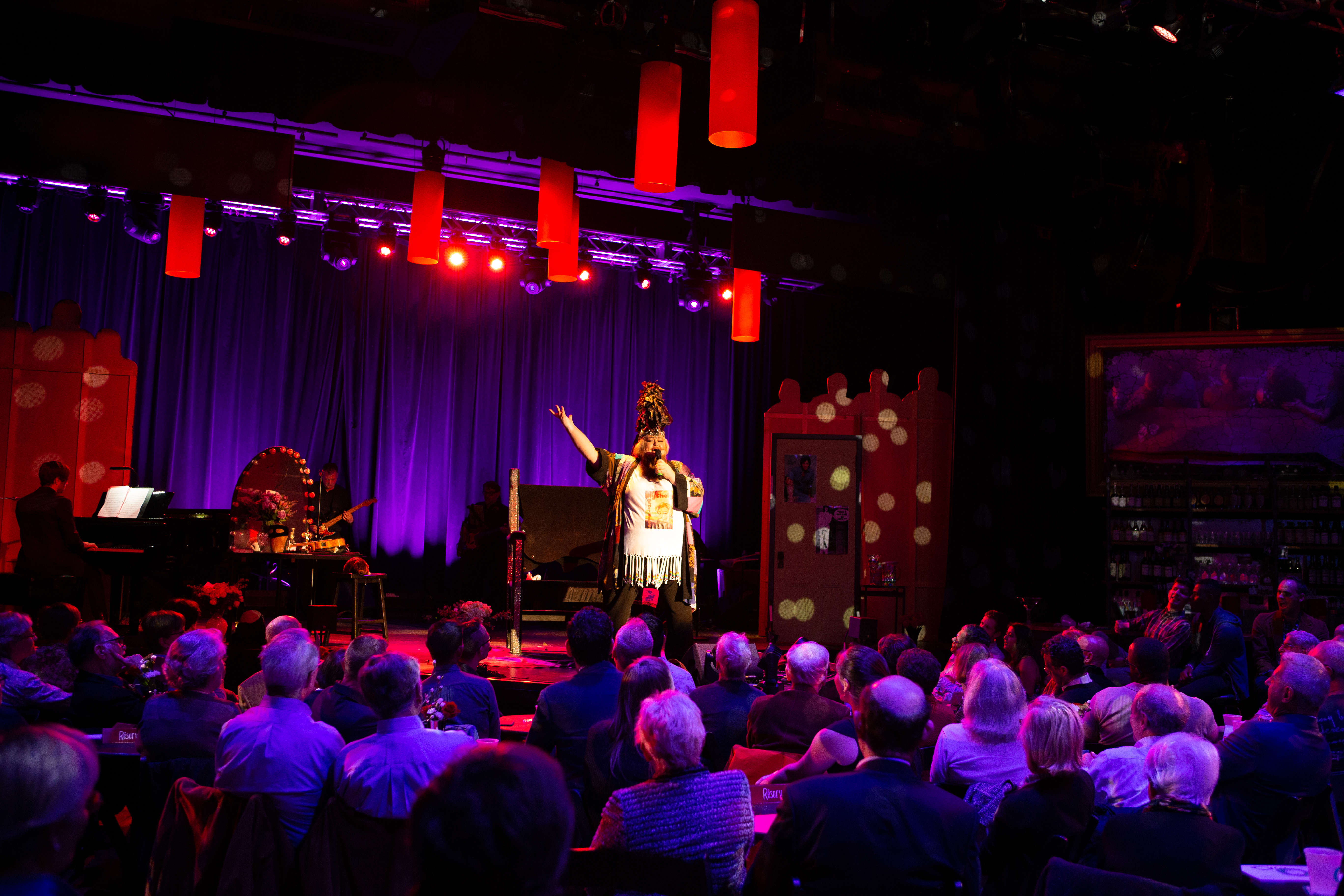
Blythely Oratonio says goodnight to a sea of adoring fans in Blythely After Hours at the Theatre of Living Arts; photo by Dominic M. Mercier





